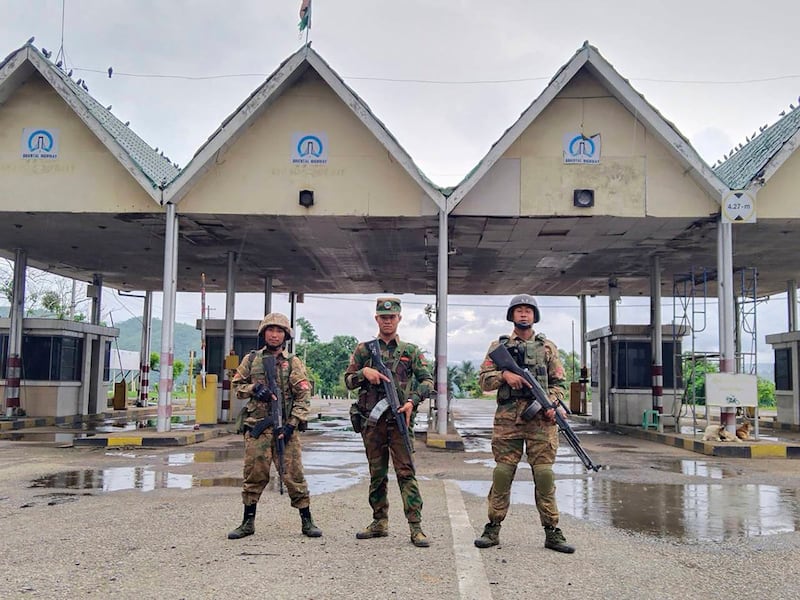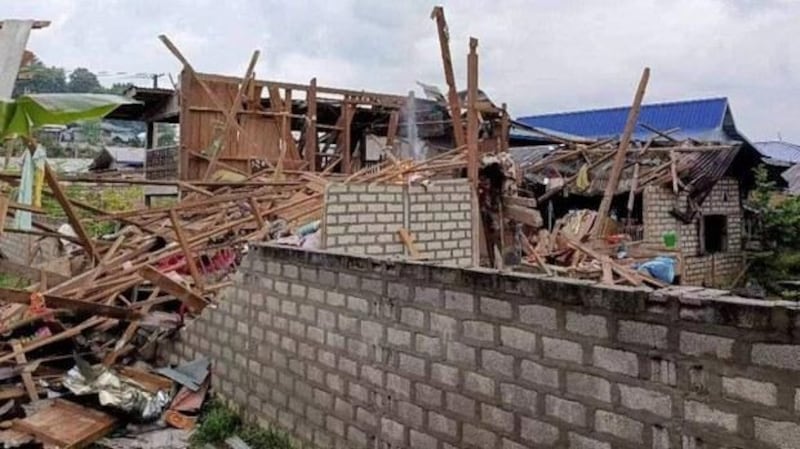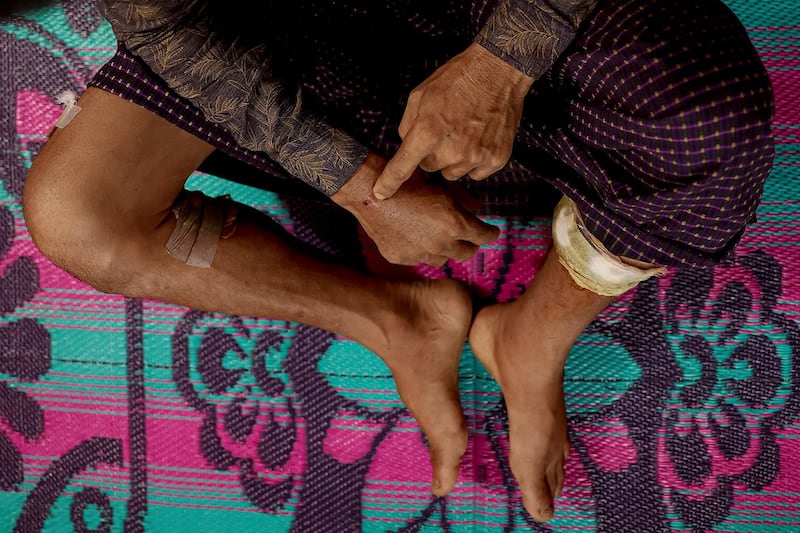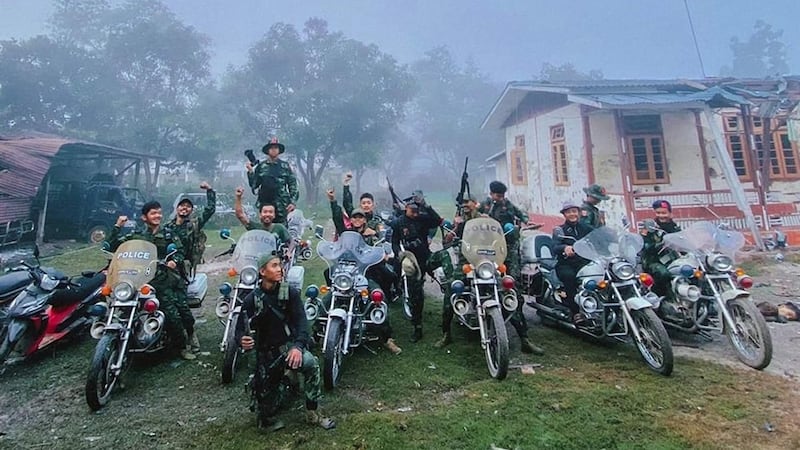Eight months after the Three Brotherhood Alliance of ethnic armies started to turn the tide in Myanmar’s civil war with a campaign against the military junta known as Operation 1027, fighting is heating up with the end of a Chinese-brokered ceasefire.
The Ta'ang National Liberation Army resumed military operations in northern Shan state on June 25, responding to the junta's repeated artillery strikes and aerial bombing of TNLA positions. Junta forces were trying to soften up the TNLA in a bid to open up Highway 3 from Lashio, the largest town in northern Shan state, to Muse, the main border crossing to China.
The TNLA and the other two members of the insurgent alliance – the Arakan Army, from Rakhine state, and the Myanmar National Democratic Alliance Army (MNDAA), based on the Chinese border – held a meeting with the State Administrative Council (SAC), as the junta is formally known, in Naypyidaw, but the talks broke down.

The Arakan Army refused to stop their offensive in northern Rakhine state, which they now almost fully control as they fight to take Maungdaw.
The second phase of Operation 1027 has moved along nearly as quickly as the first, launched on, and named after, Oct. 27, 2023. Within days, the TNLA had taken some 26 military camps. Over 20 junta troops were killed and over 20 were captured.
After a week, the MNDAA joined the TNLA and allied militia known as people’s defense force (PDF) as they pushed west and south. In just the past week, two more towns in northern Shan state – Kyaukme and Nawnghkio – have fallen to the opposition, while Mogoke is under partial control. Momeik seems likely to fall soon.
RELATED STORIES
[ Renewed fighting drives 50,000 people from homes in northern MyanmarOpens in new window ]
[ Junta military preparations point to brutal next phase in Myanmar conflictOpens in new window ]
[ Ceasefire in northeast Myanmar ends as junta battles ethnic rebelsOpens in new window ]
[ Mired in military ‘chaos,’ Myanmar’s junta locked into struggle for survivalOpens in new window ]
The military has been trying to aerially reinforce a battalion in Nawnghkio, but the TNLA has not let up their assault of key military positions around the town. The MNDAA has captured a junta light infantry battalion in Nampaung.
More significantly, the Three Brotherhood Alliance has turned their sights on Lashio, the region’s commercial and administrative hub and a gateway to China. More symbolically, the city of 130,000 people is the headquarters of the Northeast Military Command, one of the junta’s twelve military regions.
Opposition successes in Rakhine and Kachin
It had long been assumed that Lashio was a redline that would trigger a Chinese response, but the TNLA and MNDAA are now closing in on the city, routinely striking it with artillery. Seven people were killed in a clash in early July.
As a sign of just how nervous the junta is about losing Lashio, its forces destroyed five bridges into the town.
In Rakhine state on Myanmar’s west coast, the Arakan Army captured the Thandwe airport on July 5, as well as a light infantry battalion in Maungdaw, a key city on the border with Bangladesh. They continue to surround Ann township, an important transportation hub and the headquarters of the Western Military Command.
The Arakan Army claims to have killed over 900 soldiers in recent fighting, though there has been no independent verification of this.
Given the junta’s inability to resupply troops, the lightly garrisoned southern half of Rakhine is now within reach of the Arakan Army.

In Myanmar's north, heavy rains in Kachin state have caused massive flooding, road closures, and the dislocation of over 23,000 people. The monsoon weather has caused the Kachin Independence Army (KIA) to slow their offensive after months of significant gains.
Today, the KIA controls all border crossings into China, and much of the highway from the state capital Myitkyina to Sumprabum.
When fighting resumes, the southern Kachin logistics hub of Bhamo, with its airport, will be a strategic priority.
String of successes
The regime’s redeployment of forces, including new conscripts, to Pyin Oo Lwin and Lashio has resulted in a surprise offensive by the Mandalay People’s Defense Force, arguably the most battle hardened forces of the opposition National Unity Government (NUG).
The Mandalay rebels have had a string of successes, including an attack out of the mountains into Singu, to sever Highway 31 that connects Mandalay to Bhamo.

On Tuesday, the Mandalay PDF told the Irrawaddy online news outlet it had seized 11 junta bases in Singu township in eight days of fighting to control the Mandalay-Mogoke road. The TNLA, meanwhile told the Irrawaddy it has captured four Myanmar junta bases in northern Shan state and the Mandalay region on Tuesday.
A successful KIA offensive in Bhamo would imperil the regime’s ability to resupply from Mandalay. At the same time, the KIA’s control of large parts of the mountainous road between Mansi and the TNLA controlled border crossing at Namkhan makes any junta resupply of northern Shan state from the north almost impossible.
This is further evidence of significant coordination between the shadow government NUG and the ethnic resistance organizations.
While Operation 1027 saw significant opposition gains in northern Shan state, the southern half of the state has largely remained loyal to the junta, if for no other reason than to continue to turn out industrial quantities of methamphetamine.
The Shan State Progressive Party (SSPP) had announced that it would bandwagon with the Three Brotherhood Alliance, but thus far has failed to join in the second phase of Operation 1027. Instead, SSPP fighters have been clashing with regional rivals, the Restoration Council of Shan State.
Where the SSPP rubs shoulders with the Three Brotherhood Alliance, there have been sporadic clashes. In early July, the SSPP accused the TNLA of killing one of their officers. The TNLA briefly attacked an SSPP position in early July.
Airstrikes by a desperate military
While neither situation escalated, it highlights the difficulties of cobbling together an alliance in such a complex political-ethnic tapestry. Even when it is in groups’ strategic interests to cooperate, at the tactical level, rivalries and grievances take over.
That is unfortunate, because a good way to add to pressure on the junta would be to open a new front in southern Shan state, which for three-and-a-half years has been peaceful.
A united campaign in southern Shan could also force the military to redeploy forces from Kayah state, where the junta has two columns moving to fully retake the state capital Loikaw from Karenni opposition forces.
The recapture of the city is a priority for the regime, and would be a symbolic loss for Myanmar’s opposition, which is otherwise making substantial gains in many regions.
Nonetheless, the Karenni setback is a cautious reminder of the limits to opposition resources and logistics. Despite the junta’s military setbacks and economic ineptness, superior resources remain one of their key strategic advantages.

The junta offensive has once again demonstrated that the military is largely unable to resupply and reinforce troops in remote regions, and that their only response are spasmodic airstrikes of limited military utility.
While some airstrikes are based on good intelligence and have military value, such as a mid-June strike on a meeting of PDF leaders in Sagaing that led to the death of 16, most air strikes target civilians.
An estimated 359 civilians have been killed and 756 wounded in 819 airstrikes in the first four months of 2024, according to one monitoring group – which notes the operational tempo in 2024 is up to seven sorties a day, as the junta military desperately tries to undermine support for a surging opposition.
Zachary Abuza is a professor at the National War College in Washington and an adjunct at Georgetown University. The views expressed here are his own and do not reflect the position of the U.S. Department of Defense, the National War College, Georgetown University or Radio Free Asia.
